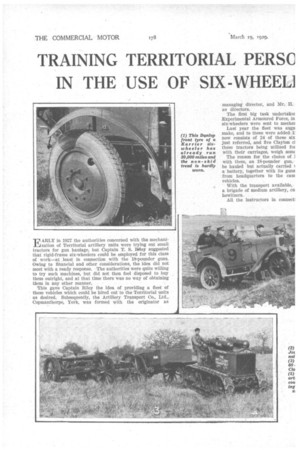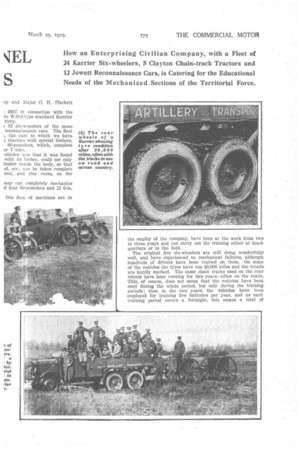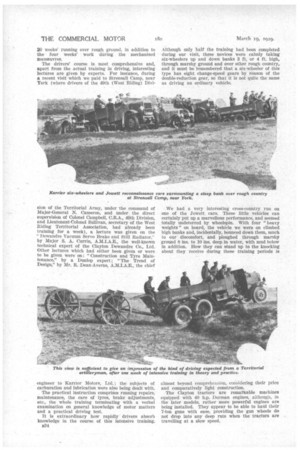TRAINING TERRITORIAL PERK ■ ZEL IN THE USE OF SIX -WHEEL]
Page 58

Page 59

Page 60

If you've noticed an error in this article please click here to report it so we can fix it.
flow an Enterprising Civilian Company, with a Fleet of 24 Karrier Six-wheelers, 5 Clayton Chain-track Tractors and 12 Jowett Reconnaissance Cars, is Catering for the Educational Needs of the Mechanized Sections of the Territorial Force.
MI ARLY in 1927 the authorities concerned with the mechani
A ` zation of Territorial artillery units were trying out small tractors for gun haulage, but Captain T. S. Riley suggested that rigid-frame six-wheelers could be employed for this class of work—at least in connection with the 18-pounder guns. Owing to financial and other considerations, the idea did not meet with a ready response. The authorities were quite willing to try such machines, but did not then feel disposed to buy them outright, and at that time there was no way of obtaining them in any other manner.
This gave Captain Riley the idea of providing a fleet of these vehicles which could be hired out to the Territorial units as desired. Subsequently, the Artillery Transport Co., Ltd., Copmanthorpe, York, was formed with the originator as managing director, and Mr. H. as directors.
The first big task undertake' Experimental Armoured Force, in six-wheelers were sent to mechai
Last year the fleet was augn make, and to these were added I now consists of 24 of these six just referred, and five Clayton c] these tractors being utilized fol with their carriages, weigh somE The reason for the choice of ] with them, an 18-pounder gun, be hauled but actually carried a battery, together with its guns from headquarters to the cam vehicles.
With the transport available, a brigade of medium artillery, co howitzers.
All the instructors in connect ey and Major O. Er, Plackett
:-.-1927 in connection with the ve W.0.6-type standard Karrier
:ttery. • r..15 six-wheelers of the same reconnaissance cars. The fleet the cars to which we have tractors with special limbers,
60-pounders, which, complete 2r 7 tons.
rehicles was that it was found with its /lather, could not only limber inside the body, so that Lel, etc., can be taken complete und, and vice versa, on the any can completely mechanize If four 6.0-pounders and 12 6-in.
this fleet of machines are in the employ of the company, have been at the work from two to three years and can carry out the training either at headquarters or in the field.
The original five six-wheelers are still doing wonderfully well, and have experienced no mechanical failures, r although hundreds of drivers have been trained on them. On some of the vehicles the tyres have run 30,000 miles and the tre.acis are hardly marked. The same chain tracks used on the rear wheels have been running for two years—often on the roads. This, of course, does not mean that the vehicles have been used during the whole period, but only during the training periods; thus, in the two years, the vehicles have been employed for training five batteries per year, and as each training period covers a fortnight, this means a total of
20 weeks' running over rough ground, in addition to the four weeks' work during the mechanized manceuvres.
The drivers' course is most comprehensive and, apart from the actual training in driving, interesting lectures are given by experts. For instance, during a recent visit which we paid to Strensall Camp, near York (where drivers of the 49th (West Riding) Divi sion of the Territorial Army, under -the command of Major-General N. Cameron, and under the direct supervision of Colonel Campbell, C.R.A., 49th Division, and Lieutenant-Colonel Sullivan, secretary of the West Riding Territorial Association, had already been training for a week), a lecture was given on the "Dewandre Vacuum Servo Brake and Still Radiator," by Major S. A. Currin, A.M.I.A.E., the well-known technical expert of the Clayton Dewandre Co., Ltd. Other lectures which had either been given or were to be given were on: "Construction and Tyre Maintenance," by a Dunlop expert; "The Trend of Design," by Mr. R. Dean-Avenis, A.M.IA.E., the chief
engineer to Karrier Motors, Ltd.; the subjects of carburation and lubrication were also being dealt with.
The practical instruction comprises running repairs, maintenance, the care of tyres, brake adjustments, etc., the whole training terminating with a verbal examination on general knowledge of motor matters and a practical driving test.
It is extraordinary how rapidly drivers absorb knowledge in the course• of this intensive training. E34
Although only half the training had been completed during our visit, these novices were calmly taking six-wheelers up and down banks 3 ft. or 4 ft. high, through marshy ground and over other rough country, and it must be -remembered that a six-wheeler of this type has eight change-speed gears by reason of the double-reduction gear, so that it is not quite the same as driving an ordinary vehicle.
We had a very interesting cross-country run on one of the Jowett cars. These little vehicles can certainly put up a marvellous performance, and seemed totally undeterred by wheelspin. With four "heavy weights" on board, the vehicle we were on climbed high banks and, incidentally, bounced down them, much to our discomfort, and ploughed through marshy ground 8 ins. to 10 ins, deep in water, with mud below in addition, How they can stand up to the knocking about they receive during these training periods is almost beyond comprehension, considering their price and comparatively light construction.
The Clayton tractors are remarkable machines equipped with 40 h.p. Dorman engines, although, in the later .models, rather more powerful engines are being installed. They appear to be able to haul their 7-ton guns with ease, providing the gun wheels do not drop into any deep ruts when the tractors are travelling at a slow speed..




















































































































